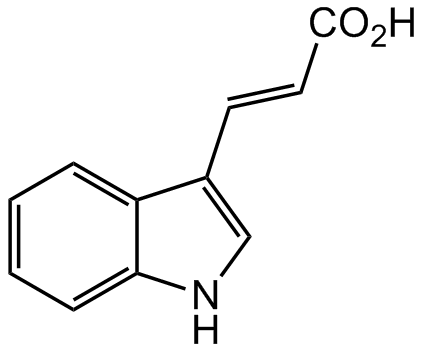
Chemical Structure
trans-Indole-3-acrylic acid
AG-CR1-3677
CAS Number29953-71-7
Product group Chemicals
Estimated Purity>98%
Molecular Weight187.2
Overview
- SupplierAdipoGen Life Sciences
- Product Nametrans-Indole-3-acrylic acid
- Delivery Days Customer10
- CAS Number29953-71-7
- CertificationResearch Use Only
- Estimated Purity>98%
- Hazard InformationWarning
- Molecular FormulaC11H9NO2
- Molecular Weight187.2
- Scientific DescriptionChemical. CAS: 29953-71-7. Formula: C11H9NO2. MW: 187.2. Synthetic. Inflammation suppressor. Tryptophan metabolite produced by human microbiota (intestinal commensale Peptostreptococcus sp). Involved in keeping the intestinal barrier intact and works as anti-inflammatory molecule. Patients with Inflammatory bowel Disease (IBD) have an altered microbiota, with less Peptostreptococcus sp., and therefore reduced production of trans-indole-3-acrylic acid. Chromophoric L-Trp analog used to probe the allosteric properties of the internal aldimine of tryptophan synthas. Also shown to be a moderate inhibitor of tryptophan synthase, trypothan-2,3-dioxygenase, indoleamine-2,3-dioxygenase, L-dopachrome isomerase and xanthine oxidase. Reagent used as a matrix for MALDI-TOF mass spectroscopy in order to characterize and analyze polyphenols and synthetic polymers. Used as heterocyclic building block or intermediate for the synthesis of indolyl acrylamide-derived inhibitors, pharmaceuticals or agrochemicals. - Inflammation suppressor. Tryptophan metabolite produced by human microbiota (intestinal commensale Peptostreptococcus sp.). Involved in keeping the intestinal barrier intact and works as anti-inflammatory molecule. Patients with Inflammatory Bowel Disease (IBD) have an altered microbiota, with less Peptostreptococcus sp. and therefore reduced production of trans-indole-3-acrylic acid. Chromophoric L-Trp analog used to probe the allosteric properties of the internal aldimine of tryptophan synthase. Also shown to be a moderate inhibitor of tryptophan synthase, trypothan-2,3-dioxygenase (TDO), indoleamine-2,3-dioxygenase (IDO), L-dopachrome isomerase and xanthine oxidase. Reagent used as a matrix for MALDI-TOF mass spectroscopy in order to characterize and analyze polyphenols and synthetic polymers. Used as heterocyclic building block or intermediate for the synthesis of indolyl acrylamide-derived inhibitors, pharmaceuticals or agrochemicals.
- SMILESO=C(/C=C/C1=CNC2=CC=CC=C21)O
- Storage Instruction2°C to 8°C
- UNSPSC12352200

![trans-3-Indoleacrylic acid [29953-71-7]](https://www.targetmol.com/group3/M00/02/43/CgoaEWY7KCeEOw6VAAAAAEui7no467.png)